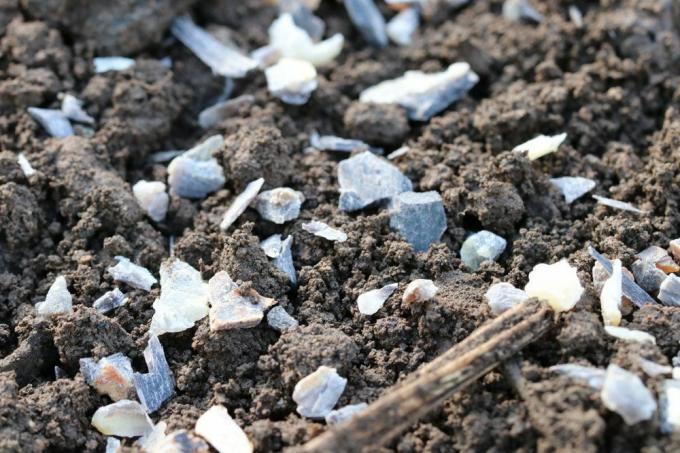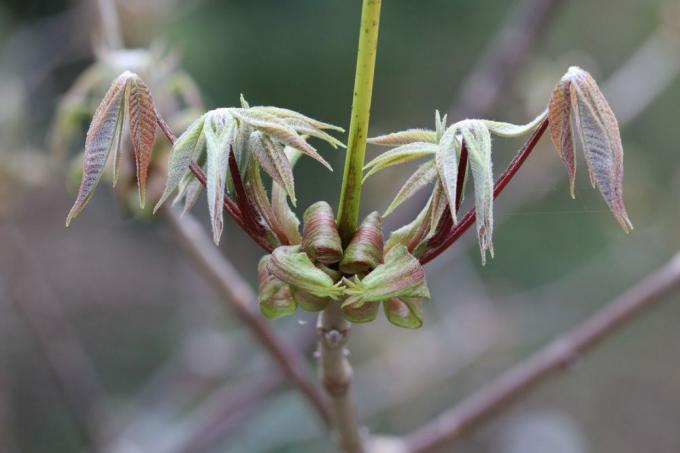
table of contents
- Characteristics
- care
- Heyday
- Soil & location
- Fertilize
- Harvest time
- to water
- Origin & growth
- Diseases & pests
- plants
- Plant neighbors
- Cut
- Overwinter
- Multiply
Profile and care information open +conclude -
- Flower color
- White
- Location
- Partial shade, sunny
- Heyday
- July August
- Growth habit
- expansive, bushy, overhanging
- height
- up to 4 meters high
- Soil type
- sandy, loamy
- Soil moisture
- moderately moist, fresh
- PH value
- neutral, slightly acidic
- Limescale tolerance
- Calcium tolerant
- humus
- rich in humus
- Plant families
- Soap Tree Family, Sapindaceae
- Plant species
- Ornamental shrubs
- Garden style
- Natural garden, forest garden
The bush chestnut is a good alternative to a large chestnut tree in a small garden. Because as the name suggests, it is a shrub plant. In the summer, the decorative flower candles are formed, from which the chestnuts develop later in the autumn, but which are smaller than those of the common horse chestnut. The bush horse chestnut is very adaptable and therefore easy to care for and an asset to any garden corner. The following article explains everything about appropriate care.
Characteristics
- also bush horse chestnut
- bot. Name Aesculus parviflora
- broad, spreading shrub
- Flowering from July to August
- white flowers
- leaves bronze-colored when shoots
- green in summer
- Autumn color yellow
- deciduous
- hardy
care

Caring for the bush horse chestnut (Aesculus parviflora) is very easy. Since it is a shrub that also grows in the wild in a forest, it requires little attention from the gardener. Because he takes care of himself, so to speak. Of course, there are always enough nutrients on a forest floor due to the fallen leaves, so it is important to also cultivate them in the garden You should fertilize bush chestnuts regularly and in hot periods you should also water them regularly, but otherwise there is not much in caring for the sturdy bush to be observed.
Heyday
Last but not least, the broad shrub is valued in the local gardens for its graceful flowering. In July, small white flowers form on long, upright panicles. So it looks like the bush is covered with candles all over. The flowers also have the following properties:
- pleasant scent in the evenings
- many night butterflies fly to the flowers
- bloom well into August
Soil & location
The bush chestnut is very adaptable and can tolerate a location in full sun as well as partial shade. The shrub even thrives under trees when there is light shade. Another plus point of the robust bush chestnut is that it can also thrive in urban climates and can therefore be an asset to all garden corners. And that even if this corner is directly on a busy street. The soil at the locations described should then be as follows:
- well permeable
- fresh and always slightly damp
- possibly slightly acidic
- there should be good water flow
- Avoid waterlogging
Tip: If you want to put the bush chestnut in the limelight, then plant Aesculus parviflora as a solitary on a spacious lawn or in front of an evergreen hedge.
Fertilize

Once a year in spring before budding, the bush chestnut should be given fertilizer for proper care. Abundant flowering can be expected in summer. And new shoots can also be formed more quickly from the shrub. When fertilizing should be proceeded as follows:
- fertilize with compost and horn shavings
- sprinkle around the plant
- fold in carefully
- Do not damage the roots
- no further fertilization is required
- Spread mulch all year round
Harvest time
The chestnuts can be harvested in autumn. However, the fruits of the bush chestnut are smaller than those of the horse chestnut. The capsule fruits are thornless, yellow-brown and can be picked up between September and October. However, they are not edible but, like the large fruits of the chestnut trees, can also be used for handicrafts or dried to light a fireplace.
to water
The soil around the chestnut should always be slightly moist and not dry out. Nevertheless, waterlogging should be avoided at all costs. Therefore, the shrub needs to be watered more often during hot periods of heat in summer. Ideally, this is done as follows:
- use captured rainwater
- Use early morning or late evening hours for watering
- always on the roots
- also note the foothills to the side
- therefore water widely around the plant
Origin & growth

The shrub is originally native to the light forests and forest edges in North America. But due to its origin in the northern parts of the world, the shrub is also very robust in the local latitudes. The shrub belongs to the soap tree family (Sapindaceae) and here to the horse chestnuts (Aesculus). The bush chestnut has broad subterranean runners and can thus grow into a very large shrub. It grows up to four meters high. In addition, the following should be mentioned about the growth of the bush horse chestnut:
- more broad than tall in old age
- a width of up to ten meters can be achieved
- Basic shoots grow upright in an arching manner
- get denser over the years
Diseases & pests
Aesculus parviflora is very robust and therefore not susceptible to the leaf miner, which often damages horse chestnuts. Nevertheless, there can be damage to the shrub which, in a distant sense, is related to incorrect care. These look like this:
- yellowed leaves
- Salt concentration in the soil too high
- can come from road salt in winter
Tip: You can prevent the high salt concentrations in winter by not planting the shrub directly on a sidewalk that is strewn with salt in winter. If you have to clear snow and ice from this path and sidewalks in your garden in winter, then use ash or granulate and not salt for scattering.
plants

If a new bush chestnut from the trade is to be planted, then spring is the right time for this. No more frosty nights should be expected. Therefore, May right after the ice saints is particularly suitable. When planting, attention should be paid to the following:
- Dig and prepare the soil
- Plant hole twice as wide and deep as the ball of plants
- a little deeper for drainage
- Place stones on the bottom of the planting hole
- Mix earth with gravel or sand
- also fold in compost
- Insert the bush straight
- Fill in soil all around
- kick well
- water enough
Tip: For the shallow root, loosen the soil a little further next to the planting hole. This allows the shrub to grow faster and its roots to spread in all directions.
Plant neighbors
Since the bush chestnut grows into a stately plant that also grows very wide, it is not advisable to create a flower bed right next to it. Because here the chestnut plant would inevitably grow into it with the long roots and thus displace the plants cultivated here. Therefore, some space should be left in the immediate vicinity. The shrub can also be used as an underplant for other tall trees. Provided that there is light shadow. The bush buckeye becomes a special eye-catcher next to a rhododendron and can also serve as a privacy screen.
Cut

Regular pruning is important so that the bush horse chestnut does not become too big and sprawling. The right time for this is late winter. Because now sick branches and branches damaged by frost or moisture in winter can also be removed. You should proceed as follows:
- Carry out parenting cuts
- remove all broken branches
- cap directly at the base
- also clear
- remove all dense branches
- so the bush gets more air again
- Use only clean and disinfected cutting tools
- the cutting tools should also be sharp
Note: The bush chestnut usually does not need a pruning, as it also grows wild in the forest and does well here without a pruning. Nevertheless, it makes sense in the garden to remove the damaged shoots so that the shrub looks more decorative again.
Overwinter
When wintering, not much needs to be considered, because Aesculus parviflora is absolutely hardy. It can withstand temperatures down to -23 ° Celsius, which are usually not reached in the local latitudes. A layer of mulch is sufficient as winter protection here. This prevents both the rapid drying out of the soil in winter sun and the penetration of snow and frost. However, if the mulch layer becomes too muddy, it should be replaced. Bark mulch has proven itself here. Furthermore, the following should be observed in winter:
- there are definitely cold dry periods
- the shrub could dry up with little water
- therefore pour on frost-free days
- Use lukewarm water
Note: You can mulch a garden all year round and not just in winter. In this way, the plants are better protected from drying out, even in summer. In addition, the mulch layer regularly releases nutrients into the soil and absorbs them from the roots of the plants.
Multiply

So that the bush horse chestnut does not grow too wide, the lateral runners are dug up and separated from the remaining roots with a knife. This should be done once a year in the spring. The newly obtained plants are too good to dispose of. Therefore, these can be replanted as offshoots at a different location. The procedure is as explained under “Plants”. The bush horse chestnut can also be propagated as follows:
- by lowerers
- lower fresh shoots in spring
- fix in the ground with a bent nail
- Separate from mother plant when roots form
- plant in a suitable location
- by cuttings
- choose new shoots
- stuck in the ground with two eyes
- keep well moist
- plant in place when roots form
Tip: If you cannot use any more chestnuts in the garden yourself because there are no free corners, you can also use them Ask neighbors or friends with a garden whether they are interested in the cuttings that you remove due to the size of the plant had to.
